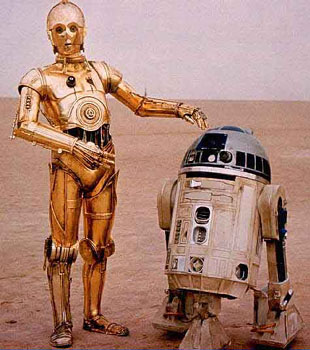Out-of-body Ideation
By Peter LloydYou’d think that if you were looking for ways to make a robot move more smoothly, you might find ideas by studying the way humans move. Not a bad place to start, but you might also want to take a close look at the way fish move as well. The best ideation practitioners help their clients find solutions by providing them with stimulation not only from expected models but from less-than-obvious models.
 Let’s say you want to build a better robot. More specifically a robot that moves more smoothly than those we’re used to seeing clomping around. So far, it seems, robot designers have used the human body as their model. But who says a robot has to move like a human? Why would it want to walk on two legs, have a face, talk from a mouth, look you in the eye? Maybe the designers of R2D2 got it right.
Let’s say you want to build a better robot. More specifically a robot that moves more smoothly than those we’re used to seeing clomping around. So far, it seems, robot designers have used the human body as their model. But who says a robot has to move like a human? Why would it want to walk on two legs, have a face, talk from a mouth, look you in the eye? Maybe the designers of R2D2 got it right.If design should serve purpose, if form should follow function, then the machines we might like to have clean our homes, serve us in restaurants, or run for public office need not look like us. Certainly the ideal model for making a robot move as smoothly as possible doesn’t have to come from the human body. Evolution has left it far from perfect in many ways, including motion.
In pursuit of better mechanical motion, some scientists have been studying fish and how they swim in order to design medical prosthetics for humans. In the process, they have come to some counter-intuitive insights. As always, when creative people such as designers and inventors look beyond the obvious for inspiration, they make fresh and often surprising discoveries. In this case, they found their assumptions about fish motion not only wrong but the opposite of reality. What they have learned will directly improve the function and flexibility of next-generation prosthetics.
When you invent, design, innovate, or pursue any other creative enterprise, you will always find inspiration by observing obvious models. But not-so-obvious models are also worth examining. The not-so-obvious, however, encompasses the rest of the universe. So where do you begin to look? Choose models not for how closely they resemble the final form you envision but rather for how well the model accomplishes the function you want to achieve.
 The Wright brothers, as you would expect, in addition to learning all there was to know about aerodynamics at the time, studied the flight of birds in their efforts to invent the airplane. From the bird, an obvious model, they concluded that they would have to achieve wing warping—make the trailing edges of the wings of their flying machine twist in opposite directions. The design solution for wing warping came not from bird wings but from an inner-tube box that Wilbur noticed himself twisting absentmindedly in the Wright bike shop one day.
The Wright brothers, as you would expect, in addition to learning all there was to know about aerodynamics at the time, studied the flight of birds in their efforts to invent the airplane. From the bird, an obvious model, they concluded that they would have to achieve wing warping—make the trailing edges of the wings of their flying machine twist in opposite directions. The design solution for wing warping came not from bird wings but from an inner-tube box that Wilbur noticed himself twisting absentmindedly in the Wright bike shop one day.Obviously you can’t predict where you’ll find a Wright-like invention model or design trigger, but you can keep your eyes open for inspiration from anywhere.
See also:
Peter Lloyd is co-creator with Stephen Grossman of Animal Crackers, the breakthrough problem-solving tool designed to crack your toughest problems.
